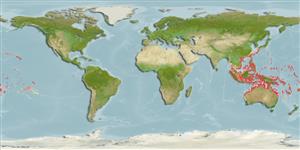>
Eupercaria/misc (Various families in series Eupercaria) >
Labridae (Wrasses) > Corinae
Etymology: Macropharyngodon: Greek, makros = great + Greek, pharyngx = pharynx + Greek,odous = teeth (Ref. 45335).
More on author: Valenciennes.
Environment: milieu / climate zone / distribuzione batimetrica / distribution range
Ecologia
marino associati a barriera corallina; non migratori; distribuzione batimetrica 0 - 60 m (Ref. 128797), usually 0 - 30 m (Ref. 27115). Tropical; 24°C - 28°C (Ref. 27115); 30°N - 30°S, 94°E - 124°W
Indo-Pacific: Cocos-Keeling Islands in the eastern Indian Ocean to western Pacific and islands of Oceania.
Size / Peso / Age
Maturità: Lm ? range ? - ? cm
Max length : 15.0 cm SL maschio/sesso non determinato; (Ref. 9823)
Spine dorsali (totale) : 9; Raggi dorsali molli (totale) : 11; Spine anali: 3; Raggi anali molli: 11; Vertebre: 25. Color in life of young and females whitish to greenish with irregular black spots; males orange-red with greenish yellow spots (edged in blue and black, per scale); head spotted and banded. Anterior lateral line scales with 2-4 pores. Pelvic fins short, not reaching anus.
Body shape (shape guide): fusiform / normal; Cross section: compressed.
Inhabits subtidal reef flats and outer lagoon and seaward reefs (Ref. 1602). Usually in areas with mixed sand, rubble, and coral (Ref. 9710). Feeds mainly on gastropods, other hard-shelled prey (Ref. 9823), and foraminiferans (Ref. 37816). Rarely marketed.
Life cycle and mating behavior
Maturità | Riproduzione | Deposizione | Uova | Fecundity | Larve
Oviparous, distinct pairing during breeding (Ref. 205).
Randall, J.E., 1978. A revision of the Indo-Pacific labrid fish genus Macropharyngodon, with descriptions of five new species. Bull. Mar. Sci. 28(4):742-770. (Ref. 2694)
IUCN Red List Status (Ref. 130435: Version 2025-1)
Threat to humans
Harmless
Human uses
Pesca: commerciale; Acquario: Commerciale
Strumenti
Special reports
Download XML
Fonti Internet
Estimates based on models
Preferred temperature (Fonte Biblio.
123201): 24.7 - 28.9, mean 27.7 °C (based on 770 cells).
Phylogenetic diversity index (Fonte Biblio.
82804): PD
50 = 0.5002 [Uniqueness, from 0.5 = low to 2.0 = high].
Bayesian length-weight: a=0.00977 (0.00466 - 0.02049), b=3.07 (2.90 - 3.24), in cm total length, based on LWR estimates for this (Sub)family-body shape (Ref.
93245).
Trophic level (Fonte Biblio.
69278): 3.1 ±0.4 se; based on diet studies.
Resilienza (Fonte Biblio.
120179): Alto, tempo minimo di raddoppiamento della popolazione meno di 15 mesi (Preliminary K or Fecundity.).
Fishing Vulnerability (Ref.
59153): Low vulnerability (10 of 100).
🛈
Nutrients (Ref.
124155): Calcium = 87.4 [51.0, 145.0] mg/100g; Iron = 0.717 [0.422, 1.341] mg/100g; Protein = 18.3 [15.4, 20.5] %; Omega3 = 0.149 [0.095, 0.231] g/100g; Selenium = 23.3 [14.4, 41.4] μg/100g; VitaminA = 147 [46, 547] μg/100g; Zinc = 1.87 [1.30, 3.01] mg/100g (wet weight);
